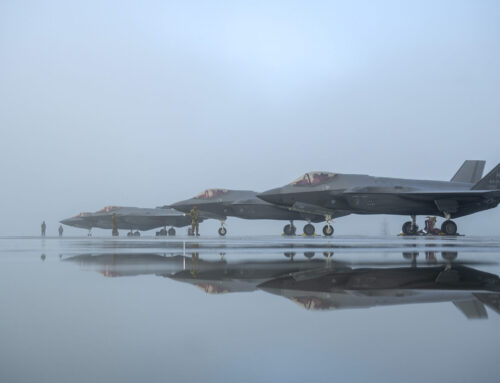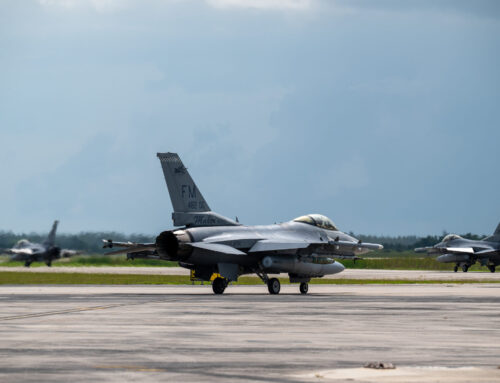Chief of Space Operations Gen. Chance Saltzman delivers a keynote address on the state of the Space Force during the Air and Space Forces Association 2024 Warfare Symposium in Aurora, Colo., Feb. 13, 2024. (US Air Force photo by Eric Dietrich)
WASHINGTON — A new memo from Chief of Space Operations Gen. Chance Saltzman sets out to redefine how the Space Force conceptualizes space operations, reframe the service’s missions and creates new “terms of reference” for official use.
More than just an updated dictionary, it’s a move that “lays down a marker for the Space Force,” Doug Loverro, former head of Pentagon space policy, told Breaking Defense. “This is actually a lot more important to forming the force then selecting uniforms and songs.” But it’s also generated some concern in the military space community.
The memo on “Military Space Operations Terms of Reference,” dated Sept. 24 and obtained by Breaking Defense, lays out three “core functions” for the Space Force, defines space “mission areas” and their component “mission sets,” and explains cross-cutting “enterprise functions” that support the core functions.
“To ensure unity of effort, it is necessary for the Space Force to define common terms of reference (TOR) for military space operations (MSO). A common lexicon ensures clarity and precision across the enterprise, including but not limited to concept development, resource decisions, organizational structures, training, and threat reporting. This TOR serves as a frame of reference to drive understanding and alignment across the Service,” Saltzman writes in his introduction to the new document.
“The attached TOR defines the operational and enterprise activities a military force either red or blue could perform in, from, or to the space domain. Moving forward, the Space Force will normalize lexicon and messaging around the terms described therein.”
The Space Force’s three core functions are described as follow:
Space Control: “Space Control comprises the activities required to contest and control the space domain. The desired outcome of Space Control operations is Space Superiority, a degree of control that allows forces to operate at a time and place of their choosing without prohibitive interference from space or counterspace threats, while also denying the same to an adversary.
“Space Control consists of offensive and defensive actions, referred to as counterspace operations. Counterspace operations are conducted across the space, electromagnetic spectrum, and ground segments of the space architecture.”
For example, the first mission area listed under Space Control is “Orbital Warfare,” explained as “Combat operations conducted through fires, movement, and maneuver to control the space domain.” (The memo here marks a further erosion in recent months of the semantic wall separating space operations from offensive combat operations, which officials had jealously guarded in the past.)
Global Mission Operations: “Activities to deliver space capabilities to the Joint Force and the nation.” This core function effectively is the catchall for traditional space support missions, including satellite communications and missile warning/missile tracking.
It also includes a new mission area called “Space-Based Sensing and Targeting” that includes among its subordinate mission sets “Moving Target Indicator,” defined as the effort to “[c]ollect, process, and disseminate track data on moving targets in the terrestrial domains.”
Space Access: “The movement and sustainment of equipment in, from, and to the space domain.” This includes the “Space Lift” mission area defined as: “The movement of payloads (spacecraft or other materials) to and from the space domain.” Launch and “recovery” of payloads are described as mission sets under Space Lift.
Mixed Reception
Since Saltzman’s memo was circulated last week, the effort’s initial reception by military space professionals both current and retired, as well as outside analysts, has been far from unified.
Some, like Loverro, praised the framework document as necessary for the newest service shape its role in the joint force, and create commonality of purpose internally.
“I do think this is appropriate coming from the CSO’s [Chief of Space Operation’s] office,” Loverro said. “[T]hese terms have been defined and redefined over the years — but it is good for the Space Force to have a compendium of terms they use.”
Others fretted that the document was developed in somewhat of a vacuum, both internally within the service and externally. In particular, a handful of sources — former and current officials and other close observers — said it does not appear to have been closely coordinated with US Space Command, considering that the new document in some ways doesn’t reflect command thinking. This is despite the fact that, as a combatant command, SPACECOM is charged with conducting space operations and developing the requirements for doing so.
The Space Force, by contrast and by law, is not a warfighting entity. Rather it is charged with organizing, training and equipping forces and “presenting” them to SPACECOM and other combatant commands to deploy to the field.
SPACECOM did not respond by press time to a query about whether its leaders or personnel had been involved in the document’s drafting. Asked by Breaking Defense if the document had been “coordinated” with SPACECOM Commander Gen. Stephen Whiting, a Space Force spokesperson replied: “Yes, it has been shared with Gen. Whiting and USSPACECOM.
Further, the spokesperson stressed, that the TOR “was developed by an HQ team with inputs from the [field commands].”
There’s also the potential for confusion, as a number of sources also pointed out that the TOR document features concepts and terms that differ from those laid out in current Defense Department policies and joint doctrine, the latter of which prescribes how the US military fights as a joint force.
The differences could mean a disconnect among the military services as well as with SPACECOM and the other combatant commands, and complicate battlefield operations, the sources worry.
“What stands out to me is that [Saltzman] is attempting to define the core functions and missions of the Space Force in a way that does not align with DOD 5100.1, which defines the core functions and missions of all the military services,” said Todd Harrison, of the American Enterprise Institute and long-time space policy guru.
“It seems like it would be prudent to get the foundation right by updating and clarifying the Space Forces core functions in DOD 5100.1 before attempting to build a complicated structure of frameworks and terms of reference. Otherwise, it seems like this is something that will not align with the rest of the department or the combatant commands, and thus will have limited utility,” he said.
Doctrinal Chickens And Eggs
Likewise, several current and former Air and Space Force officials pointed out that the new TORs do not always align with those laid out in joint doctrine governing US military space operations, Joint Publication (JP) 3-14.
The latest update of JP 3-14, signed off in August 2023, was crafted under the leadership of SPACECOM in close coordination with the Space Force and the Joint Staff, as well as representatives from the other services and combatant commands. That document — which has not been made public but was obtained by Breaking Defense — lays out 10 space mission areas for the joint force’s space operations. The TOR document, using slightly different terminology, establishes 11 mission areas for the Space Force grouped under the three core functions.
For example, one obvious difference between the two documents is that while the new TORs set “Space Control” as a Space Force core function, JP 3-14 deliberately dropped the term “space control” and had it excised from the definitive “DoD Dictionary of Military and Associated Terms”.
Similarly, “orbital warfare” does not appear either as a mission area or a defined term in JP 3-14.
A Space Force spokesperson explained that the TOR document should be seen as kick-starting the service’s process of creating its own doctrine — something for which each military service is responsible, and which then informs joint force doctrine development. Meaning, Saltzman’s new terms eventually could be reflected in a later joint doctrine publication.
“This is an initial step towards defining our service doctrine as an armed service focused on the space domain. As we mature space concepts and operations, we’ll likely find alignment between Service and Joint Doctrine definitions at the operational level,” the spokesperson said.
The trouble is that for now, since the joint doctrine for space ops has been approved, JP 3-14 actually supersedes the Space Force’s doctrine, meaning Saltzman’s mission categories don’t necessarily carry weight outside of his service. The same goes for terms of reference.
“Joint doctrine defines terms for Joint operations. Services have their own terms of reference to suit their unique needs. Any service or combatant command with interest in changing a Joint term can advocate for a change through the standard Joint doctrine review process,” explained a spokesperson for the Joint Staff.
“Over time, Joint doctrine terms adapt to best capture the changing character of war and evolving Joint force approaches. As space is a relatively new domain, doctrine terms and updates are likely to occur more rapidly as the Space Force and space operations develop,” the spokesperson added.
Finally, another potential problem for the new mission area construct is that it does not comport with how the Space Force categorizes programs into mission areas in its budget and reports on its activities to Congress, several sources said. One consultant who works closely with Capitol Hill said this could pique complaints as staff has to try to match budget documents to service acquisition programs.
That problem, however, is one that may disappear after the current budget cycle, one Space Force official noted. The fiscal 2027 budget simply could be constructed to parallel the TOR document, the official said.











